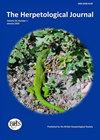Incorporating habitat suitability and demographic data for developing a reintroduction plan for the critically endangered yellow spotted mountain newt, Neurergus derjugini
IF 1.1
4区 生物学
Q3 ZOOLOGY
引用次数: 5
Abstract
In reintroduction programmes for amphibians, data on age structure in hosting populations and choices of life stage or age groups in releasing captive bred individuals are often missing. Similarly, employing site selection procedures for selecting appropriate reintroduction locations are often neglected. Here, we obtained data on longevity, age at maturation, and age structure from skeletochronological data in a free living population of the yellow spotted mountain newt, Neurergus derjugini. A maximum longevity of 13 years for males and 12 years for females showed that N. derjugini is a long living newt with a stable age structure. We also employed maximum entropy modelling, geographic information system, and multicriteria decision analysis to obtain ranked suitability scores for reintroduction sites. Finally, we determined post-release survival rates for different life stage and age groups of N. derjugini including 30 eggs and 60 individuals of six-months old larvae, one and three-year old juveniles, and six-year old adults (15 each) born and raised in a captive-breeding facility and released into mesh enclosures in a selected stream. Over 10 visits to the site before and after overwintering, the survival rates for eggs, larvae, one and three-year juveniles and six-year old adults were 25, 80, 86.66, 93.33 and 53.33 % respectively. Applying survival rates obtained from current experimental reintroductions through a static life table suggest that an optimal release strategy to arrive at a numerical target of 100 adults aged three can be achieved by reintroduction of 650 fertilised eggs and fostering them in meshed enclosures in the selected stream.结合栖息地适宜性和人口统计数据,为极度濒危的斑点山蝾螈Neurergus derjugini制定重新引入计划
在两栖动物的重新引入计划中,关于宿主种群的年龄结构以及释放圈养个体时生命阶段或年龄组的选择的数据往往缺失。同样,采用选址程序来选择适当的重新引入地点往往被忽视。在这里,我们从一个自由生活的黄斑点山蝾螈Neurergus derjugini种群的骨骼年代数据中获得了关于寿命、成熟年龄和年龄结构的数据。雄性和雌性的最大寿命分别为13年和12年,这表明德朱吉尼蝾螈是一种长寿蝾螈,年龄结构稳定。我们还采用了最大熵建模、地理信息系统和多准则决策分析来获得重新引入地点的适宜性评分。最后,我们确定了不同生命阶段和年龄组的德朱吉尼猪笼草的放生后存活率,包括30个卵和60个6个月大的幼虫、1岁和3岁的幼鱼以及6岁的成虫(每个15个),它们在圈养繁殖设施中出生和长大,并被放生到选定溪流的网罩中。越冬前后10次以上,卵、幼虫、一年期和三年期幼体和六年期成虫的存活率分别为25%、80%、86.66、93.33和53.33%。通过静态生命表应用从当前实验性重新引入中获得的存活率表明,通过重新引入650个受精卵并将其培育在选定溪流的网状围栏中,可以实现达到100名三岁成年人数量目标的最佳释放策略。
本文章由计算机程序翻译,如有差异,请以英文原文为准。
求助全文
约1分钟内获得全文
求助全文
来源期刊

Herpetological Journal
生物-动物学
CiteScore
2.40
自引率
10.00%
发文量
25
审稿时长
>12 weeks
期刊介绍:
The Herpetological Journal is the Society''s prestigious quarterly scientific journal.
 求助内容:
求助内容: 应助结果提醒方式:
应助结果提醒方式:


